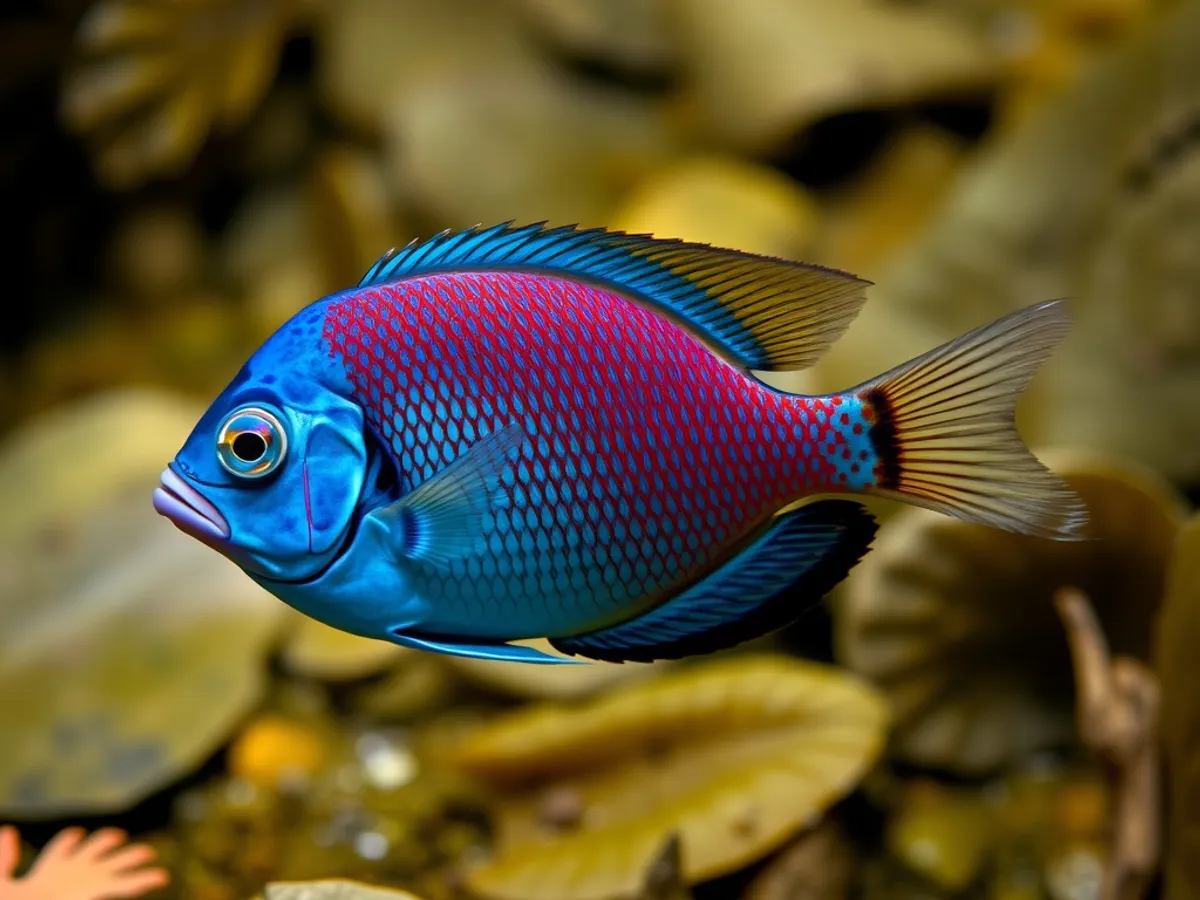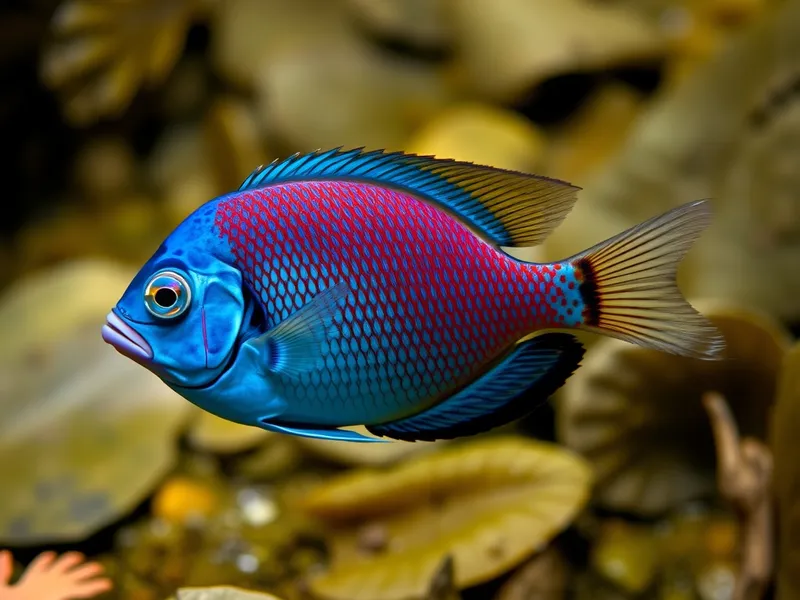
Blue Discus
Symphysodon aequifasciatus

Meet the Blue Discus
The Blue Discus is a strikingly beautiful freshwater fish native to the Amazon River basin in South America. Known for its round, disc-shaped body and vivid blue coloration with iridescent patterns, it is a favorite among aquarium enthusiasts worldwide. Blue Discus are social fish, often found in small groups and displaying intricate social behaviors. They prefer calm, warm waters with dense vegetation and are sensitive to changes in their environment. Their unique appearance and delicate nature make them both a challenge and a delight for experienced aquarists.
Classification
Fish
Habitat
Freshwater rivers and floodplains
Diet
Omnivore
Lifespan
10-15 years
Conservation
Least Concern
Weight
150-250 grams
📖Fascinating Facts
Unique Shape
Blue Discus have a nearly perfect disc-shaped body, which helps them navigate through dense underwater vegetation.
Parental Care
Both male and female Blue Discus provide parental care, with fry feeding on a special mucus layer secreted by the parents' skin.
Sensitive Species
Blue Discus require stable, clean water conditions and are very sensitive to environmental changes, making them a challenge for aquarists.
📋Detailed Description
The Blue Discus (Symphysodon aequifasciatus) is a medium-sized cichlid, typically reaching 15–20 cm (6–8 inches) in diameter, with a laterally compressed, disc-shaped body that facilitates maneuverability among submerged roots and dense aquatic vegetation. Its coloration varies from iridescent blue to brown, often with vertical dark bars (usually 8–9) and intricate, metallic blue-green patterning on the face and fins. The eyes are large and red to orange, providing enhanced vision in the dim, tannin-stained waters of the Amazon. Fins are rounded and continuous, aiding in precise, hovering movements. Blue Discus are highly social, forming loose shoals that exhibit complex dominance hierarchies and cooperative behaviors. Their laterally compressed bodies and small, terminal mouths are specialized for grazing on biofilm, detritus, and small invertebrates. They possess well-developed lateral lines for detecting subtle water movements, essential for communication and predator avoidance. The species is renowned for its advanced parental care, with both sexes participating in brood defense and larval feeding. Adapted to lentic (slow-moving) habitats, Blue Discus are sensitive to water quality, requiring stable, warm temperatures (25–32°C) and slightly acidic to neutral pH (5.2–7.7). Their striking appearance and intricate behaviors have made them a model organism for studies of sociality and parental investment among Neotropical fishes.
💡 Did you know?
Despite their calm appearance, Blue Discus can be quite territorial, especially during breeding season, and will fiercely protect their eggs and young.
🔬Research & Sources
Wikipedia Summary
Symphysodon aequifasciatus, the blue discus or brown discus, is a species of cichlid native to rivers of the eastern and central Amazon Basin downriver from the Purus Arch. This discus is found in black-, clear- and whitewater, but its preference for lentic habitats such as floodplains and flooded forests means that the whitewater it inhabits contain little suspended material. It is largely restricted to water with a high temperature of 25–32 °C (77–90 °F) and a pH of 5.2–7.7.
Last Modified: 7/5/2024
🎭Behavior & Social Structure
Blue Discus are diurnal and spend much of their day foraging in small groups, grazing on periphyton, detritus, and small aquatic invertebrates. They exhibit pronounced social structures, with dominant individuals securing the best feeding and breeding sites. Social interactions include lateral displays, fin flaring, and subtle color changes to communicate status or readiness to spawn. During feeding, they use their small mouths to pick at surfaces, often in synchrony with conspecifics. When threatened, they may form tight schools or seek refuge among submerged roots and vegetation. Aggression is generally low outside of breeding, but territorial disputes can arise during spawning. They are known for their 'pair bonding' behavior, where mated pairs remain close and coordinate activities, especially during breeding and fry rearing.
👶Reproduction & Life Cycle
Blue Discus are biparental substrate spawners, forming monogamous pairs during the breeding season, which coincides with the onset of the Amazonian flood pulse (typically November to May). Courtship involves mutual cleaning of a flat surface, synchronized swimming, and color intensification. Females lay 100–400 adhesive eggs on cleaned leaves or submerged wood, which are then fertilized by the male. Both parents fan the eggs to prevent fungal growth and remove infertile or damaged eggs. Incubation lasts 48–60 hours at optimal temperatures. Upon hatching, larvae remain attached to the spawning site for 3–4 days, absorbing yolk sacs. Unique among cichlids, discus fry feed on a nutrient-rich mucus secreted by the skin of both parents for up to two weeks post-hatching, a phenomenon known as 'dermal feeding.' Parental care continues until the fry are free-swimming and able to forage independently.
🛡️Adaptations & Survival
Symphysodon aequifasciatus exhibits several key adaptations for survival in the Amazon floodplain. Its disc-shaped body allows for agile navigation through dense aquatic vegetation and submerged debris. The species' coloration provides camouflage against dappled light and tannin-stained waters. Specialized mucous glands in adults facilitate dermal feeding of fry, a rare adaptation among fishes. Their well-developed lateral line system enhances detection of water movement, crucial for social communication and predator avoidance in turbid environments. Physiologically, Blue Discus are adapted to tolerate low dissolved oxygen and variable water chemistry, a necessity in seasonally flooded habitats. Their omnivorous diet and ability to exploit a range of microhabitats confer ecological flexibility.
📚Research Sources
🎨Cultural Significance
The Blue Discus holds significant value in the global aquarium trade, prized for its beauty and complex behaviors. In its native range, it is sometimes featured in local folklore as a symbol of tranquility and harmony due to its graceful movements and social nature. The species has become an icon among aquarists, inspiring numerous selectively bred color morphs and international competitions. In scientific research, it serves as a model for studies on parental care, sociality, and adaptation to floodplain environments.
🔬Recent Research & Discoveries
Recent genetic studies have clarified the taxonomy of Symphysodon, revealing complex patterns of hybridization and cryptic diversity within the genus. Ongoing research focuses on the molecular basis of skin mucus composition and its role in fry nutrition and immunity. Ecological studies are examining the impact of flood pulse dynamics on discus reproductive timing and population structure. Advances in captive breeding techniques have improved fry survival and reduced reliance on wild-caught individuals. Behavioral research continues to explore the mechanisms underlying pair bonding and social hierarchy formation.
🎥Wildlife Videos

Blue Whisper - The Fascinating World Beneath the Waves | Free Documentary Nature
Blue Whisper - The Fascinating World Beneath the Waves | Ocean Documentary Watch 'Adventure Ocean Quest: Discovering ...
Free Documentary - Nature

Exploring The Underwater World | 4K UHD | Blue Planet II | BBC Earth
Travel to the depths of our mysterious oceans to discover all kinds of curious creatures underwater – from fish that communicate ...
BBC Earth

Incredible 4K Nature Scenes Narrated By David Attenborough | BBC Earth
Relax with extraordinary 4K nature footage narrated by Sir David Attenborough, the voice of natural history for over 70 years.
BBC Earth

Desert Seas Narrated by David Attenborough | National Geographic Documentary
Along the east and west coasts of Saudi Arabia are two seas that contain a treasure of marine life that few knew existed -- and ...
J Roz

David Attenborough | Nature Documentary To Fall Asleep To (ai)
"Life on Earth" is your gateway to the breathtaking world of wildlife and natural wonders. Through captivating documentaries, we ...
Life on Earth - David Attenborough

Awe-Inspiring Nature Scenes in 4K UHD | BBC Earth
Enjoy the best 4K wildlife footage that BBC Earth has to offer, narrated by Sir David Attenborough, David Tennant and more!
BBC Earth
🌍Habitat Information
The Blue Discus typically inhabits Freshwater rivers and floodplains environments. Blue Discuss have adapted to their environments with specialized features and behaviors.
Primary Habitat:
Freshwater rivers and floodplains
More detailed habitat information will be available soon.
🛡️Conservation Status
The Blue Discus is currently classified as Least Concern. Conservation efforts are crucial for preserving this species for future generations.
Common Threats:
- 🏠Habitat loss and fragmentation
- 🌡️Climate change impacts
- 🎯Hunting and poaching
- 🏭Human-wildlife conflict
⚠️Threats & Conservation Challenges
While currently listed as Least Concern by the IUCN, Blue Discus populations face localized threats from habitat degradation, deforestation, and water pollution due to agricultural runoff and mining. Overharvesting for the ornamental fish trade, especially of wild-caught specimens, has impacted some populations, although captive breeding now supplies most of the aquarium market. Climate change poses a long-term threat by altering flood regimes and water quality in the Amazon Basin. Invasive species and disease outbreaks are additional concerns in both wild and captive populations. Conservation challenges include maintaining habitat connectivity and water quality, as well as regulating sustainable harvests.
🔬Scientific Classification
Scientific Name
Symphysodon aequifasciatus
Classification Hierarchy
🔍 About Taxonomic Classification
Taxonomic classification is a hierarchical system used by scientists to classify and organize living organisms based on shared characteristics and evolutionary relationships.
The system moves from broad categories (Kingdom) to increasingly specific ones, with each animal's scientific name typically consisting of its Genus and species.
📝Community Notes
Share your observations and insights about the Blue Discus with our community of wildlife enthusiasts.
Join Our Community
Sign in to share your observations and connect with fellow wildlife enthusiasts.
Sign In to ContributeNo community notes yet
Be the first to share your observations about the Blue Discus!
Explore Blue Discus
Select a tab above to learn more about this amazing animal.
📸Photo Gallery
No photos available for this animal yet.
🌟Discover More Wildlife
Continue your journey of discovery with more fascinating animals from our database
